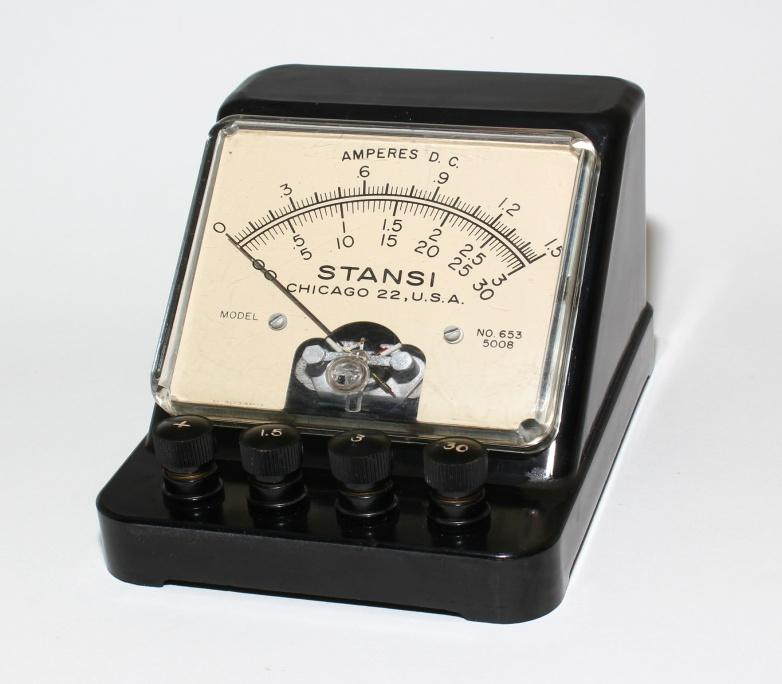Difference Between Ammeter and Galvanometer
An ammeter and a galvanometer are two major instruments that are used to measure electric current through circuits. The basic difference between the two is that an ammeter measures current only in magnitude, while a galvanometer shows the direction and magnitude of the current. Measurement of current with accuracy is quite necessary to understand the working of any electrical device. In this article, we shall learn about the ammeter, its function, and uses, and similarly, the galvanometer and the way it differs from other measuring devices like the voltmeter. We will also see how a galvanometer can be converted to an ammeter. Students will clearly get an idea of how these devices are applied in physics and electrical experiments.
This Story also Contains
- What is the function of an ammeter?
- What is a Galvanometer?
- What is The Difference Between An Ammeter And a Galvanometer?
- What is a Voltmeter?
- Difference Between Galvanometer and Voltmeter
- What is Difference Between Ammeter and Voltmeter
- How to Convert Galvanometer to Ammeter

Also read -
What is the function of an ammeter?
An ammeter is an electrical instrument used to measure the electric current flowing through a circuit. The current is measured in amperes (A), which is why the device is called an “ammeter.”

It is always connected in series with the circuit so that the entire current flows through it. Ammeters have very low resistance to ensure they do not change the amount of current in the circuit.
Types of ammeter:
Ammeter is classified into the following types depending on the constructing principle.
- The permanent magnet moving coil ammeter: In this type, the ammeter is kept in the middle of the pole of a permanent magnet. Here, the magnitude of the current doesn’t affect the deflection in the coil. Direct current is measured by this ammeter.
- Rectifier type ammeter: Alternating current is measured by this type of ammeter.
- Moving iron ammeter: Current passing through the coil affects the deflection of the coil. Both direct and alternating current is measured by this ammeter.
- Electrodynamometer type ammeter: It is more accurate than other types of ammeter. It also measures both the currents.
Depending on the current measurement, the ammeter is divided into further two types. They are AC ammeter and DC ammeter.
What is the use of an ammeter?
Ammeter is used in many sectors.
- To check the circuit problems, electricians use an ammeter.
- It is used to examine the temperature in a thermocouple.
- It measures the electric current produced by the circuit.
- The proper functioning of electronic devices is checked by an ammeter.
What is a Galvanometer?
A device that measures small electric current produced by the deflection of a moving coil is called a galvanometer.
What does a galvanometer do?
The magnetic effect of electric current is the working principle of the galvanometer. A deflection is observed in the galvanometer’s needle if there is a current in the circuit.
Types of galvanometer:
Types of galvanometer comprise:
- Tangent galvanometer
- Mirror galvanometer
- Ballistic galvanometer
- Astatic galvanometer
What is the reduction factor of the tangent galvanometer?
To generate a specific deflection, the amount of current needed to pass through the galvanometer is called the reduction factor of the tangent galvanometer.
What is the use of a galvanometer?
The galvanometer is used in the following examples:
- Laser TV, laser displays, laser engraving, etc use galvanometers to manage their systems.
- The galvanometer is used to measure the condition of hard drives and CD players.
What is The Difference Between An Ammeter And a Galvanometer?
Although both the ammeter and galvanometer measure electric current, they have difference between them. They are,
|
Ammeter
|
Galvanometer
|
|
An electric device that measures the current is called an ammeter.
| A mechanical device that measures the current is called a galvanometer. |
| In an ammeter, only the magnitude of the current is measured. | Both the magnitude and direction of the current are measured by the galvanometer. |
| Ammeter detects both direct and alternating currents. | Galvanometer detects only direct current. |
| For an ammeter, the magnetic field is not required. | The functioning of a galvanometer requires a magnetic field. |
| Ammeter is connected in series with the circuit directly. | Using the potentiometer, the galvanometer measures current. |
| Ammeter is less sensitive. | A galvanometer is more sensitive. |
| Ammeter is more accurate. | A galvanometer is less accurate. |
Read Also :
What is a Voltmeter?
In an electric circuit, an instrument calculating the electrical potential difference between two ends is called a voltmeter. It measures voltages in volts. The potential difference of either direct or indirect current is measured by the device.
Types of voltmeter:
Types of voltmeters based on the construction principle are,
- The permanent magnet moving coil voltmeter
- Rectifier type voltmeter
- Induction type voltmeter
- Electrostatic type voltmeter
- Electro dynamometer voltmeter
- Digital voltmeter
Difference Between Galvanometer and Voltmeter
Galvanometer and voltmeter differ as follows:
- A galvanometer measures the current in the circuit while a voltmeter is a device that calculates the electrical potential difference between two ends in a circuit.
- The direction of current is measured by the galvanometer but the voltmeter doesn’t measure the current only.
- The functioning of a galvanometer requires a magnetic field whereas a voltmeter doesn’t require a magnetic field.
- The circuit connection is in series in the case of the galvanometer while it is parallel in the case of the voltmeter.
What is Difference Between Ammeter and Voltmeter
| Ammeter | Voltmeter |
| Measures electric current. | Measures electric voltage (potential difference). |
| Connected in series in a circuit. | Connected in parallel across the circuit. |
| Has low resistance. | Has high resistance. |
| Symbol – A | Symbol – V |
| Unit – Ampere (A) | Unit – Volt (V) |
How to Convert Galvanometer to Ammeter
A galvanometer can be converted into an ammeter by connecting a low resistance (called a shunt resistor) in parallel with it.
A galvanometer is a very sensitive device it can only measure very small currents. To measure large currents, most of the current must be diverted away from the galvanometer.
Also check-
- NCERT Exemplar Class 11th Physics Solutions
- NCERT Exemplar Class 12th Physics Solutions
- NCERT Exemplar Solutions for All Subjects
NCERT Physics Notes :
Frequently Asked Questions (FAQs)
Milliammeter has greater resistance than an ammeter.
To detect small currents we use a galvanometer.
The galvanometer is connected in series.
An ammeter measures only the magnitude of current in a circuit, while a galvanometer measures both the direction and magnitude of current. The ammeter is used for higher currents, whereas the galvanometer is more sensitive and used for detecting small currents.
A galvanometer is a type of measuring instrument that detects and measures small electric currents, while a meter (like an ammeter or voltmeter) is designed to measure specific electrical quantities such as current, voltage, or resistance.
A galvanometer detects small currents, while a voltmeter measures the potential difference (voltage) between two points in a circuit. A high resistance is connected in series with a galvanometer to convert it into a voltmeter.
A galvanometer can be converted into an ammeter by connecting a low resistance, called a shunt, in parallel with it. This allows most of the current to pass through the shunt, protecting the galvanometer and enabling it to measure larger currents.